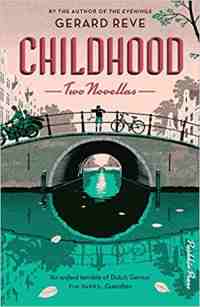Childhood: Two Novellas by Gerard Reve
 Monday, March 11, 2019 at 8:08AM
Monday, March 11, 2019 at 8:08AM 
First published in the Netherlands in 1949 and 1950; published in translation by Pushkin Press on March 12, 2019
Childhood collects two novellas that were published a few years after World War II. Both are told from a boy’s perspective.
“Werther Nieland” is the name of a “pale, sallow-skinned boy” who first meets Elmer at the home of Elmer’s developmentally disabled neighbor. Elmer narrates the story. He is also a boy, but unlike the neighbor boy and Werther, Elmer is bossy and cruel. Elmer creates clubs and appoints himself the president, but the clubs never have more than two or three members and all but Elmer are quickly expelled or quit due to Elmer’s testiness.
Elmer is a darkly imaginative child; Gerard Reve’s ability to recreate a child’s imagination is one of the story’s highlights. Elmer’s first club is dedicated to the creation of tombs and the cremation of dead (or nearly dead) birds. Elmer advises the other boys that the club has many enemies, and insists on blind obedience to the club president, who happens to be Elmer. The reader might wonder what kind of adult Elmer will turn out to be, but given the imminent Nazi invasion, it seems likely he will be drawn to the Germans.
The novella is notable for Werther’s home life. When Elmer visits Werther, Werther’s mother makes them stay inside so that she can pretend to be childlike. Werther’s father is obsessed with Esperanto; his mother seems to be obsessed with boys (or “young men” as she fondly if questionably labels them). The story’s “ick” factor begins with the mother’s ambiguously suggestive comments and is heightened when she playfully grabs Elmer’s crotch. Werther’s mother has an obvious mental illness, but Werther’s aunt attributes her behavior to a nervous condition brought on by fatigue. Perhaps that’s the way families in that place and time dealt with emotional illnesses.
“The Fall of the Boslowitz Family” is narrated by Simon, who is seven when the story begins. His parents introduce him to the Boslowitz family at a children’s party. Simon makes friendships within the family (he considers the adults to be his uncle and aunt) that last through Simon’s early teen years, when Germany invades the Netherlands. The adults talk of war, which Simon thinks will be cool to watch, but his exposure to combat is limited to watching airplanes fly overhead on their bombing runs.
The Boslowitz family is Jewish. Simon doesn’t understand and doesn’t pay much attention as Nazis begin to take Jews away, because the adult discussions he overhears do not resonate with his perspective as a child. He pays more attention when the members of the Boslowitz family are threatened. It is only the father’s paralysis that keeps him from being taken away; one of his sons is beaten on a pretext. The family is fearful of going outside and is eventually prohibited from leaving the city. They hope that the father’s physical disability and a son’s mental disability will inspire mercy. The way Simon relates those events makes clear that he is only beginning to understand what is happening.
The two novellas are very different, but they are connected by a child’s unease in a troubling world that the child cannot fully comprehend. Seeing the world from a child’s eyes reminds the reader of how children misinterpret the adult world, or try to frame it in terms they understand.
RECOMMENDED